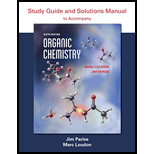
Concept explainers
(a)
Interpretation:
Whether in the given ion, the formal charge gives a fairly accurate picture of where the charge really is present is to be identified.
Concept introduction:
A charge that is assigned to an atom, on the assumption that all the electrons in the
The formal charge on an atom is calculated by the formula,
(b)
Interpretation:
Whether in the given ion, the formal charge gives a fairly accurate picture of where the charge really is present is to be identified.
Concept introduction:
A charge that is assigned to an atom, on the assumption that all the electrons in the chemical bonds are equally shared, is known as the formal charge. The sum of the formal charges on the independent atoms should equal the total charge present on the ion.
The formal charge on an atom is calculated by the formula,
(c)
Interpretation:
Whether in the given ion, the formal charge gives a fairly accurate picture of where the charge really is present is to be identified.
Concept introduction:
A charge that is assigned to an atom, on the assumption that all the electrons in the chemical bonds are equally shared, is known as the formal charge. The sum of the formal charges on the independent atoms should equal the total charge present on the ion.
The formal charge on an atom is calculated by the formula,
Want to see the full answer?
Check out a sample textbook solution
Chapter 1 Solutions
Organic Chemistry Study Guide and Solutions
- Please help me solve this reaction.arrow_forwardIndicate the products obtained by mixing 2,2-dimethylpropanal with acetaldehyde and sodium ethoxide in ethanol.arrow_forwardSynthesize 2-Ethyl-3-methyloxirane from dimethyl(propyl)sulfonium iodide using the necessary organic or inorganic reagents. Draw the structures of the compounds.arrow_forward
- Synthesize 2-Hydroxy-2-phenylacetonitrile from phenylmethanol using the necessary organic or inorganic reagents. Draw the structures of the compounds.arrow_forwardSynthesize N-Methylcyclohexylamine from cyclohexanol using the necessary organic or inorganic reagents. Draw the structures of the compounds.arrow_forwardSynthesize N-Methylcyclohexylamine from cyclohexanol using the necessary organic or inorganic reagents. Draw the structures of the compounds.arrow_forward
- If possible, please provide the formula of the compound 3,3-dimethylbut-2-enal.arrow_forwardSynthesize 1,4-dibromobenzene from acetanilide (N-phenylacetamide) using the necessary organic or inorganic reagents. Draw the structures of the compounds.arrow_forwardIndicate the products obtained by mixing (3-oxo-3-phenylpropyl)triphenylphosphonium bromide with sodium hydride.arrow_forward
- We mix N-ethyl-2-hexanamine with excess methyl iodide and followed by heating with aqueous Ag2O. Indicate the major products obtained.arrow_forwardIndicate the products obtained by mixing acetophenone with iodine and NaOH.arrow_forwardIndicate the products obtained by mixing 2-Propanone and ethyllithium and performing a subsequent acid hydrolysis.arrow_forward
 Introduction to General, Organic and BiochemistryChemistryISBN:9781285869759Author:Frederick A. Bettelheim, William H. Brown, Mary K. Campbell, Shawn O. Farrell, Omar TorresPublisher:Cengage Learning
Introduction to General, Organic and BiochemistryChemistryISBN:9781285869759Author:Frederick A. Bettelheim, William H. Brown, Mary K. Campbell, Shawn O. Farrell, Omar TorresPublisher:Cengage Learning
